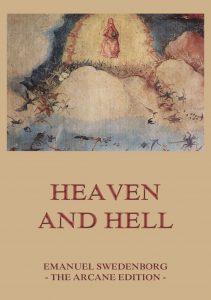Heaven and Hell – Emanuel Swedenborg
Swedenborg here unfolds the laws governing the spiritual world; describes the condition of good and evil spirits; and exhibits the general arrangement and surroundings of the inhabitants of heaven and hell. He treats of the form of heaven, in general and in particular; of its immensity, and of the innumerable societies of which it is composed; of the correspondence between the things of heaven and those of earth; of the sun of heaven, and of the light and heat proceeding therefrom; of representative appearances in heaven and of the changes of state experienced by angels; of their garments and habitations, their language and writings, their innocence and wisdom, their governments and worship; of the origin of heaven and its association with the human race by mean of the Word; of the future state of the heathen and of children, and of the occupations and joys of angels. He also treats of the World of Spirits, or the first state of man after death, and of the successive changes that he there passes through in preparation for his final abode; of the nature of hell, and the meaning of the terms “devil,” “satan,” “hell-fire,” and ” gnashing of teeth;” of the appearance, situation, and plurality of the hells, and of the wickedness and arts of infernal spirits. These presentations of the life of heaven and of hell are eminently practical, and in harmony with the teachings of Holy Scripture. They throw a flood of light upon many parts of the Word, and cannot fail to influence the lives of all who study them.
Format: Paperback.
Heaven and Hell.
ISBN: 9783849674359.
Available at amazon.com and other venues.
An introduction to Heaven and Hell (from wikipedia.com)
An article about Swedenborg includes a list of biographies about him, with a brief analysis of each biographer’s point of view. Some of the things he claims to have experienced are that there are Jews, Muslims and people of pre-Christian times (“pagans” such as Romans and Greeks) in Heaven. He says he spoke to married angel couples from the Golden Age who had been happy in heaven for thousands of years. The fundamental issue of life, he says, is that love of self or of the world drives one towards Hell, and love of God and of fellow beings drives one towards Heaven.
The work proved to be influential. It has been translated into a number of languages, including Danish, French, English, Hindi, Russian, Spanish, Icelandic, Swedish and Zulu. A variety of important cultural figures, both writers and artists, were influenced by Swedenborg, including Johnny Appleseed, William Blake, Jorge Luis Borges, Daniel Burnham, Arthur Conan Doyle, Ralph Waldo Emerson, John Flaxman, George Inness, Henry James, Sr., Carl Jung, Immanuel Kant, Honoré de Balzac, Helen Keller, Czesław Miłosz, August Strindberg, D. T. Suzuki, and W. B. Yeats. Edgar Allan Poe mentions this book in his work The Fall of the House of Usher. It also plays an important role in Honoré de Balzac’s novel Louis Lambert. William Blake referred to and criticized Heaven and Hell and Swedenborg by name several times in his poetical/theological essay The Marriage of Heaven and Hell.
Swedenborg wrote about Heaven and Hell based on what he said was revelation from God. According to Swedenborg, God is love itself and intends everyone to go to heaven. That was His purpose for creation. Thus, God is never angry, Swedenborg says, and does not cast anyone into Hell. The appearance of Him being angry at evil-doers was permitted due to the primitive level of understanding of people in Biblical times. Specifically, holy fear was needed to keep the people of those times from sinking irretrievably into the consequences of their evils. The holy fear idea was in keeping with the fundamental truth that even they could understand, that everything comes from Jehovah. In the internal, spiritual sense of the Word, however, revealed in Swedenborg’s works, God can be clearly seen for the loving Person He actually is.
(The text of the last section was taken from a Wikipedia entry and is available under the the Creative Commons Attribution-ShareAlike License.)
Publisher’s Note: This book is printed and distributed by Createspace a DBA of On-Demand Publishing LLC and is typically not available anywhere else than in stores owned and operated by Amazon or Createspace.

